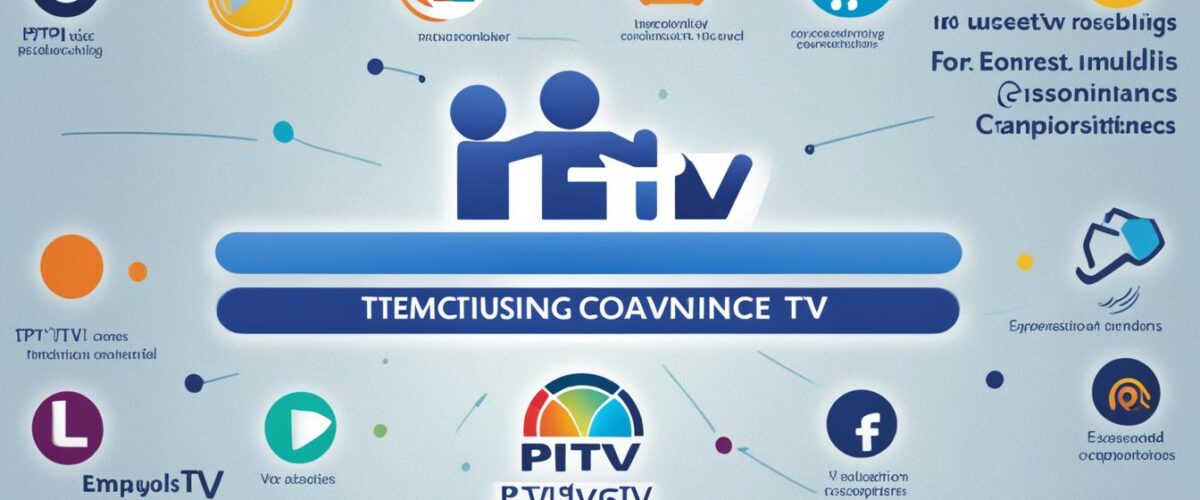Did you know that there are over 1 billion people globally who experience some form of disability? That’s approximately 15% of the world’s population. For these individuals, accessing and enjoying television programming can often present significant challenges. However, the rise of accessible TV media has paved the way for a more inclusive and immersive viewing experience for people with disabilities.
Accessible TV media incorporates essential features like closed captions, audio descriptions, and subtitles, enabling individuals with hearing, visual, cognitive, or physical disabilities to fully engage with and enjoy television content. These advancements in IPTV (Internet Protocol Television) accessibility have revolutionized the way people with disabilities can access and customize their viewing experiences, breaking down barriers and promoting inclusivity.
Unlock endless entertainment possibilities with Raw-Multimedia’s IPTV subscription services! Elevate your viewing experience to new heights with our diverse range of channels and content, starting at just $11.99. Don’t miss out on the ultimate entertainment solution – subscribe now and immerse yourself in a world of seamless streaming bliss!
Key Takeaways:
- Over 1 billion people worldwide have some form of disability.
- Accessible TV media, such as closed captions, audio descriptions, and subtitles, enhances the viewing experience for people with disabilities.
- Advancements in IPTV accessibility have made it easier for individuals with disabilities to customize their viewing experiences.
- Raw-Multimedia’s IPTV subscription services offer a diverse range of channels and content for an immersive streaming experience.
- Subscribing to Raw-Multimedia’s IPTV service allows individuals with disabilities to enjoy inclusive entertainment options at an affordable price.
The Importance of Accessible TV Media for Inclusion
Accessible TV media plays a crucial role in fostering inclusivity and ensuring that individuals with disabilities can fully participate in the shared cultural experience of television viewing. By providing features such as closed captions, audio descriptions, and subtitles, IPTV platforms and streaming services have made it possible for people with various disabilities to customize their viewing experiences according to their specific needs. This level of inclusivity not only promotes equal access to culture and leisure but also helps break down societal stigmas and prejudices towards disabilities.
The Power of Accessibility Features for IPTV
Accessibility features for IPTV, such as closed captioning, audio descriptions, and subtitles, have transformed the way people with disabilities engage with television content. These features enable individuals who are deaf or hard of hearing to fully comprehend dialogue and sound effects through text captions. Similarly, individuals with visual impairments can gain a complete understanding of visual content through audio descriptions that narrate key visual elements. Subtitles allow viewers with cognitive or language-related challenges to follow along with the dialogue, enhancing comprehension and enjoyment of the program.
With the introduction of these accessibility options, individuals with disabilities can tailor their TV viewing experience to match their specific needs and preferences. Whether it’s enabling closed captions for a more immersive experience, using audio descriptions to gain a comprehensive understanding of visual elements, or relying on subtitles for enhanced comprehension, these accessibility features empower individuals to fully participate in the cultural phenomenon of television while enjoying content that reflects their diversity.
The Impact of Inclusive IPTV Inclusivity Options
The availability of IPTV inclusivity options has not only transformed the accessibility landscape but has also had a significant impact on individuals with disabilities and society as a whole. By providing equal access to television content, IPTV platforms and streaming services promote social inclusion and help break down barriers that individuals with disabilities face in daily life.
Accessible TV media not only enhances the leisure and entertainment experience for individuals with disabilities but also promotes empathy, understanding, and acceptance within society. Through exposure to various perspectives and experiences depicted on screen, viewers can develop a more comprehensive understanding of the challenges faced by people with disabilities, thus fostering a more inclusive and compassionate society.
The Future of Inclusive Television Viewing
As the demand for accessibility continues to grow, the future of IPTV is poised to embrace even more inclusive features and functionalities. With advancements in technology, the automation of accessibility options and the use of intelligent profiles are expected to play a pivotal role in creating a personalized and seamless viewing experience.
Intelligent profiles powered by AI learning algorithms will enable IPTV systems to automatically adjust accessibility features based on individual preferences and requirements. This automation will not only simplify the customization process but also ensure that accessibility options are seamlessly integrated into the viewing experience, catering to the diverse needs of individuals with disabilities.
By prioritizing inclusivity and integrating accessibility features into their platforms, IPTV providers can become champions of equal access, ensuring that television content remains accessible and enjoyable for individuals with disabilities.
Overcoming Barriers: Disability-friendly TV Content and Media Options
The television industry has made significant efforts to overcome barriers and create disability-friendly TV content. By incorporating closed captions, audio descriptions, and simplified language, TV networks have made their programming more accessible to viewers with disabilities. Streaming services and IPTV platforms have also played a crucial role in enhancing accessibility by offering adjustable features, such as captions and audio descriptions, as well as user-friendly interfaces. Additionally, it is important for TV content to feature characters with disabilities and represent their stories and experiences, as this helps foster empathy and understanding.
Enhancing Accessibility with Closed Captions and Audio Descriptions
Closed captions and audio descriptions are essential accessibility features that have transformed the TV viewing experience for individuals with hearing or visual impairments. Closed captions provide a text representation of the audio content, allowing viewers with hearing disabilities to read the dialogue, sound effects, and other auditory elements. Audio descriptions, on the other hand, offer a narrated description of the visual elements in a TV program or movie, enabling individuals with visual impairments to understand the scenes, settings, actions, and expressions.
With the availability of closed captions and audio descriptions, individuals with disabilities can fully engage with the storyline, follow the dialogue, and comprehend the visual aspects of the content. These features not only provide equal access to entertainment but also enable individuals to participate in cultural conversations and stay connected with current events.
Customizable Features for Accessibility
Streaming services and IPTV platforms have taken accessibility to the next level by offering customizable features that cater to the unique needs of viewers with disabilities. These platforms allow users to adjust the closed captioning settings, such as font size, color, and background, according to their preferences. Similarly, individuals can customize audio description settings, such as volume and speed, to optimize their viewing experience.
Furthermore, user-friendly interfaces and navigation options make it easier for individuals with cognitive or physical disabilities to browse and access TV content. Intuitive design, clear menus, and large buttons contribute to an inclusive viewing experience, ensuring that individuals with diverse abilities can navigate through the available shows and movies effortlessly.
Representation and Empathy through Disability-friendly TV Content
Television networks and content creators have recognized the importance of representation and inclusion by featuring characters with disabilities and highlighting their stories. This not only fosters empathy and understanding but also helps break down stereotypes and societal stigmas associated with disabilities.
By portraying characters with disabilities in a realistic and respectful manner, TV content promotes diversity and challenges existing narratives. It allows individuals, both with and without disabilities, to connect with the experiences and perspectives of people who may have different abilities. This representation encourages a more inclusive society and promotes social integration.
| Benefits of Disability-friendly TV Content and Media Options | Examples |
|---|---|
| Inclusivity | TV networks incorporating closed captions, audio descriptions, and simplified language |
| Equal access to entertainment | Streaming services and IPTV platforms offering adjustable features and user-friendly interfaces |
| Empathy and understanding | TV content featuring characters with disabilities and representing their stories |
| Social integration | Portrayal of characters with disabilities in a realistic and respectful manner |
By prioritizing disability-friendly TV content and media options, the television industry is taking significant steps towards a more inclusive and accessible entertainment landscape. These efforts not only cater to the diverse needs of individuals with disabilities but also contribute to a more empathetic and understanding society.
Stay tuned for the next section, where we profile leading networks that have pioneered inclusive broadcasting services and disability-friendly TV content.
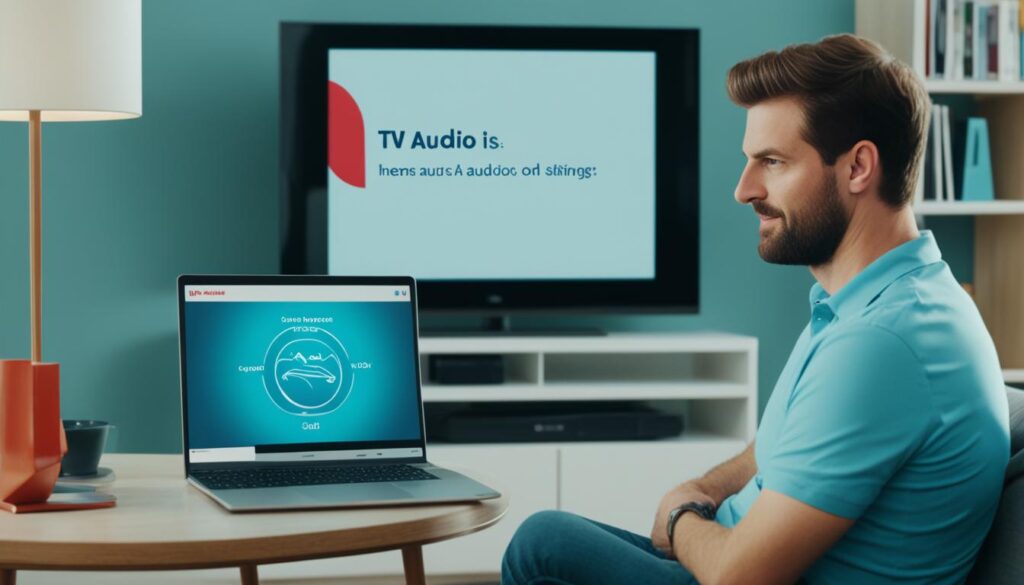
Pioneers in Inclusive Broadcasting Services: Profiles of Leading Networks
Several networks have emerged as leaders in providing inclusive broadcasting services and disability-friendly TV content. These pioneers have dedicated themselves to making their programming accessible to a wide range of viewers, including those with disabilities. Let’s take a closer look at some of these outstanding networks:
Australian Broadcasting Corporation (ABC)
The Australian Broadcasting Corporation (ABC) has been at the forefront of promoting inclusivity in television. It became the first Australian TV network to introduce audio descriptions on free-to-air television, allowing visually impaired viewers to fully experience and enjoy their favorite shows. The ABC’s commitment to accessibility extends to providing comprehensive subtitles and broadcasting programs that address disability issues.
Special Broadcasting Service (SBS)
The Special Broadcasting Service (SBS) in Australia has also made significant strides in offering disability-friendly TV content. SBS ensures that its programming is accessible to viewers with various disabilities by providing comprehensive subtitles in multiple languages. Through their diverse range of content, SBS promotes inclusivity and represents the diversity of the Australian population.
British Broadcasting Corporation (BBC)
Internationally, the British Broadcasting Corporation (BBC) is renowned for its unwavering commitment to accessibility. The BBC ensures that every program carries subtitles, sign language interpretation, and audio descriptions, allowing viewers with hearing or visual impairments to fully engage with their content. The BBC’s efforts have set a high standard for the accessibility of television programming.
Netflix
Netflix, a leading digital streaming service, has also played a pivotal role in championing inclusive entertainment options. With a wide range of accessible shows and movies, Netflix has raised the standards for disability-friendly TV content. By providing closed captions, audio descriptions, and simplified language options, Netflix ensures that its content can be enjoyed by viewers of all abilities.

Leading Networks in Inclusive Broadcasting Services
| Network | Accessibility Features |
|---|---|
| Australian Broadcasting Corporation (ABC) | Audio descriptions, comprehensive subtitles |
| Special Broadcasting Service (SBS) | Comprehensive subtitles in multiple languages |
| British Broadcasting Corporation (BBC) | Subtitles, sign language interpretation, audio descriptions |
| Netflix | Closed captions, audio descriptions, simplified language options |
These leading networks have paved the way for inclusive broadcasting services and disability-friendly TV content. Their dedication to accessibility ensures that individuals with disabilities can fully enjoy the shared cultural experience of television viewing. By setting the example, they inspire other networks and streaming services to prioritize inclusivity in their programming, fostering a more inclusive and diverse media landscape.
Accessible Shows and Movies: A Comprehensive Guide
In the changing landscape of television programming, there is a growing importance placed on inclusive television programming and disability-friendly TV content. TV networks, streaming services, and IPTV platforms are creating a wide range of accessible shows and movies that cater to the diverse needs of viewers, especially those with disabilities. These shows and movies include closed captions, audio descriptions, and simplified language to ensure that everyone can enjoy the content, regardless of their sensory or cognitive abilities.
Whether you’re a fan of dramas, comedies, documentaries, or thrillers, there’s something for everyone in the world of accessible shows and movies. With closed captions, individuals with hearing impairments can easily follow the dialogue and fully experience the storyline. Audio descriptions provide detailed narration of visual elements, enabling those with visual impairments to visualize the scenes. And simplified language ensures that individuals with cognitive disabilities can comprehend and engage with the content.
Experience the joy of inclusive television programming with these popular accessible shows and movies:
- Breaking Barriers: A heartwarming drama series that explores the challenges and triumphs of individuals with disabilities as they pursue their dreams.
- Laugh Out Loud: A hilarious comedy show that features diverse comedians who bring laughter to audiences of all abilities.
- Discovering Nature: A captivating documentary series that takes viewers on a journey through breathtaking landscapes, providing audio descriptions to enhance the experience.
- Inspirational Tales: A collection of inspiring movies that showcase the resilience and strength of individuals with disabilities, leaving viewers feeling empowered.
These are just a few examples of the accessible shows and movies that are reshaping the landscape of inclusive television programming. The commitment to providing disability-friendly TV content is bringing joy and entertainment to millions of viewers worldwide.
So, grab your popcorn, settle into your favorite spot on the couch, and immerse yourself in the world of accessible shows and movies. With the wide range of options available today, there’s no limit to the enjoyment you can experience, regardless of your abilities.
Problem Addressed: Personalization and Accessibility in IPTV Systems
IPTV systems are tackling the challenge of personalization and accessibility by introducing user profiles. These profiles allow individuals with specific accessibility needs to customize their viewing experience, making TV content more accessible and enjoyable. By incorporating personalization features, IPTV systems can create a more inclusive environment for users with disabilities, providing a seamless and tailored entertainment experience.
With user profiles, IPTV systems offer a wide range of customization options, such as:
- Adjusting user interfaces and layouts to accommodate different abilities and preferences
- Providing accessibility services, such as closed captions and audio descriptions, based on individual requirements
- Customizing content recommendations and preferences to enhance the user experience
By tailoring the viewing experience to each user’s specific needs, IPTV systems are breaking down barriers and promoting inclusivity in media consumption. User profiles empower individuals with disabilities to access a diverse range of content and enjoy entertainment on their terms.
| Benefits of IPTV User Profiles: | Challenges Addressed: |
|---|---|
| Personalized viewing experience | Ensuring accessibility for individuals with disabilities |
| Enhanced usability and navigation | Addressing diverse user preferences |
| Flexibility to customize accessibility settings | Adapting to individual requirements |
| Improved content recommendations | Enhancing user satisfaction |
With these user profiles, IPTV systems not only provide accessible media but also empower users to personalize their entertainment experience, ensuring that everyone can fully enjoy and engage with TV content.
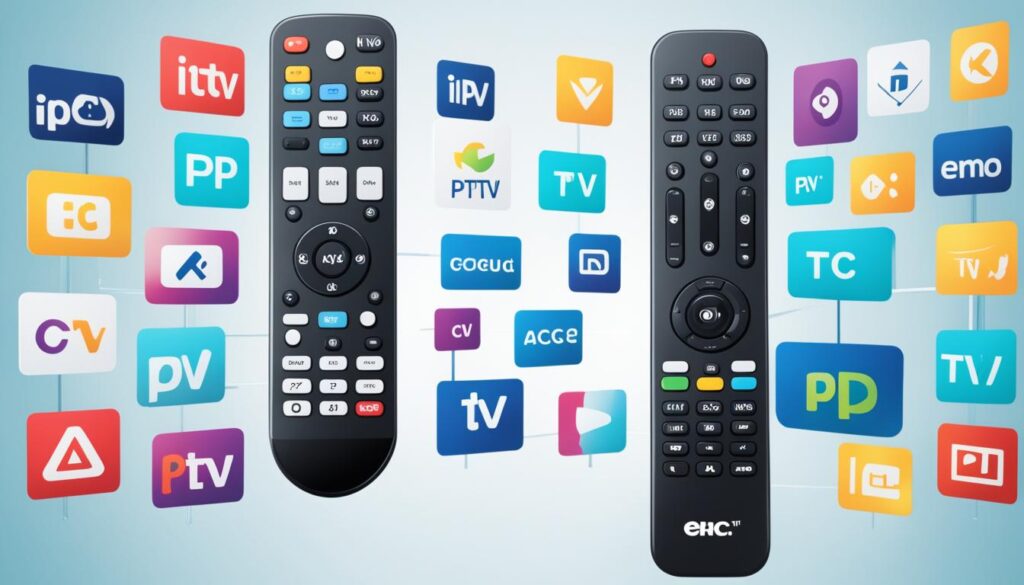
Challenges in Making Media Accessible to All
Making media accessible to all individuals, regardless of their abilities, presents several challenges. One of the main challenges is the need for developers to understand and incorporate the wide range of requirements for people with different disabilities. By considering the diverse needs of viewers, developers can create inclusive media that caters to a larger audience. However, the current approach of providing a single accessibility option may not adequately meet the needs of individuals with varying disabilities.
Accessibility challenges:
- Developing technologies that address the specific requirements of individuals with hearing, visual, cognitive, or physical disabilities
- Ensuring the provision of multiple accessibility options to cater to diverse needs
- Standardizing user profiles and accessibility options for scalability and interoperability across different platforms and devices
In order to achieve true inclusivity, it is crucial to develop media options that go beyond basic accessibility and encompass a wider range of disabilities. By incorporating the input and feedback of individuals with disabilities, developers can improve the accessibility features of media, making it more inclusive and accommodating for all users.
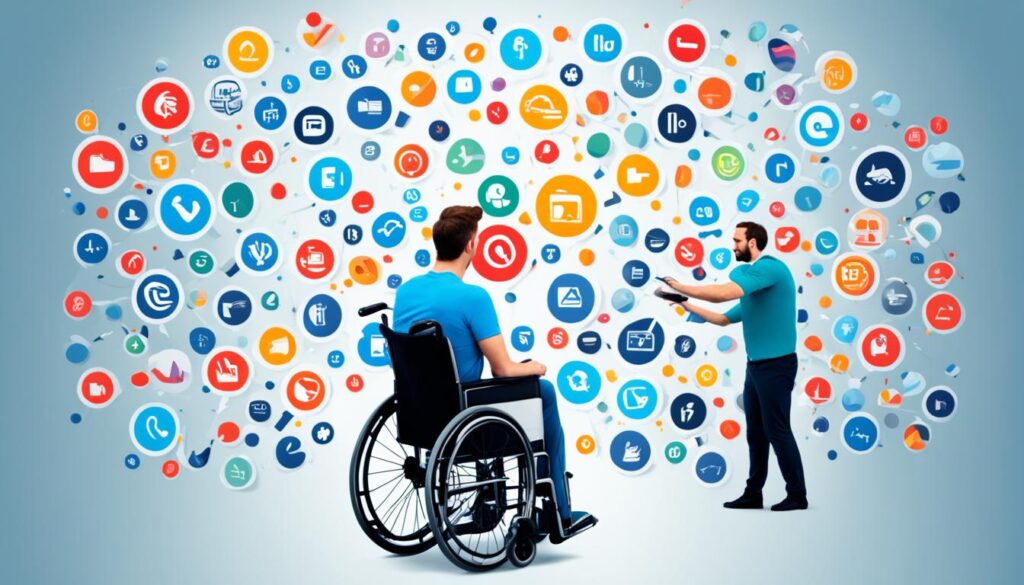
The Future of Accessible TV Media: Automation and Intelligent Profiles
In today’s rapidly evolving digital landscape, the future of accessible TV media holds exciting potential. The integration of automation and intelligent profiles is set to transform the way individuals with disabilities engage with television content. By harnessing the power of AI learning, this innovative approach aims to create a personalized and inclusive viewing experience like never before.
Automation: Enhancing Personalization
Automation technology enables the seamless customization of accessibility features based on user needs and preferences. With the ability to automatically adjust closed captions, audio descriptions, and subtitles, viewers can enjoy an immersive experience that caters to their specific requirements. This automation also extends to the adaptation of user interfaces, layouts, and navigation options, ensuring a more intuitive and enjoyable experience for individuals with disabilities.
Intelligent Profiles: Tailoring the Viewing Experience
Intelligent profiles take personalization to the next level by considering various factors such as content type, user age, and environmental conditions. These profiles intelligently adapt accessibility features in real-time, ensuring that users receive a tailored and optimal viewing experience. For example, a user profile may adjust the color contrast and font size to accommodate individuals with visual impairments, or provide simplified language options for viewers with cognitive disabilities.
The use of intelligent profiles not only enhances accessibility but also promotes inclusivity by empowering individuals with disabilities to engage fully with TV media. By catering to diverse needs and preferences, television content becomes more accessible, relatable, and enjoyable for all viewers.
The Role of AI Learning
AI learning plays a pivotal role in the future of accessible TV media. As technology continues to advance, AI algorithms can analyze user behavior, preferences, and feedback to continuously improve the accuracy and effectiveness of accessibility features. This iterative learning process enables TV providers to refine their offerings, ensuring that individuals with disabilities have access to the most comprehensive and user-friendly accessibility options available.
Moreover, AI learning facilitates the development of intelligent recommendation systems. By understanding user preferences and past viewing habits, the AI algorithms can suggest TV shows and movies that align with each individual’s interests while also considering their accessibility requirements. This personalized content curation not only enhances the viewing experience but also promotes diversity and representation in TV media.
Overall, the future of accessible TV media lies in the synergy between automation technologies, intelligent profiles, and AI learning. By embracing these advancements, TV providers can revolutionize their offerings, making television content more inclusive and accessible to individuals with disabilities. As technology continues to evolve, the potential for an immersive, personalized, and inclusive viewing experience will only continue to grow.
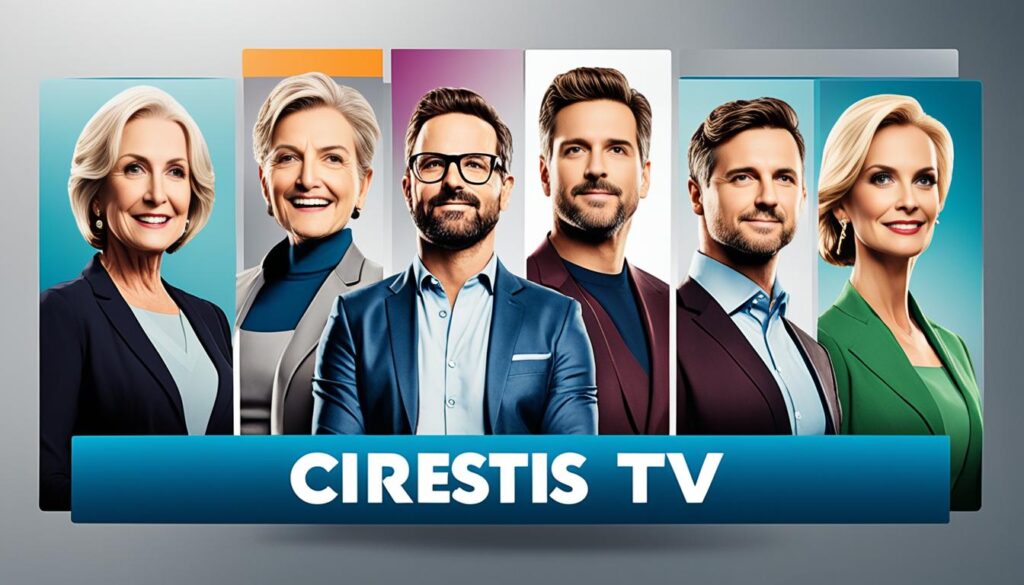
The Role of ITU-T in Defining Accessibility Profiles for IPTV Systems
The International Telecommunication Union (ITU-T) plays a crucial role in ensuring that IPTV systems provide accessibility for all individuals. ITU-T defines accessibility profiles that categorize the level of support offered by IPTV terminal devices, ranging from basic to enhanced features. These profiles enable people with disabilities to easily select terminal devices that meet their specific accessibility needs, promoting inclusivity in media consumption.
By standardizing the accessibility profiles, the ITU-T contributes to the goal of making media accessible to individuals with disabilities. This standardization ensures that IPTV systems offer consistent accessibility functions, allowing users to fully engage with and enjoy television content. Furthermore, it facilitates interoperability between different IPTV systems, promoting seamless accessibility experiences across platforms and devices.
Benefits of ITU-T’s Accessibility Profiles
- Enables individuals with disabilities to choose IPTV terminal devices tailored to their needs
- Promotes inclusivity and equal access to television content
- Ensures consistency in accessibility features across different IPTV platforms
- Facilitates interoperability between IPTV systems for seamless accessibility experiences
Through its work in defining accessibility profiles, the ITU-T plays a crucial role in creating a more inclusive and accessible media landscape. By prioritizing the needs of individuals with disabilities, IPTV systems can offer a personalized and barrier-free viewing experience for all users.
ITU-T’s Efforts in IPTV Accessibility
To further enhance accessibility in IPTV systems, the ITU-T collaborates with industry stakeholders and experts to develop and update their accessibility standards. These efforts focus on addressing emerging technologies and trends in the rapidly evolving media landscape, ensuring that accessibility profiles stay relevant and effective.
Overall, the ITU-T’s work in defining accessibility profiles for IPTV systems is pivotal in promoting inclusivity, equal access, and an enhanced viewing experience for individuals with disabilities.
Conclusion
Enhancing IPTV accessibility through closed captions, audio descriptions, and subtitles has revolutionized the viewing experience for people with disabilities. These accessibility features have played a significant role in promoting human rights, equality, and inclusion in modern society.
TV networks, streaming services, and IPTV platforms have led the charge in providing inclusive entertainment options that cater to individuals of all abilities. By offering closed captions, audio descriptions, and subtitles, these platforms are championing equal access to culture, information, and leisure.
The future of accessible TV media holds even greater potential with the advent of automation and intelligent profiles. These advancements will further enhance inclusivity and personalization in the viewing experience. Imagine a world where IPTV systems automatically adjust accessibility features based on user preferences, content types, and environmental factors.
Unlock endless entertainment possibilities with Raw-Multimedia’s IPTV subscription services. Starting at just $11.99, you can immerse yourself in a world of seamless streaming bliss and enjoy a diverse range of channels and content. Subscribe now and take your viewing experience to new heights!
